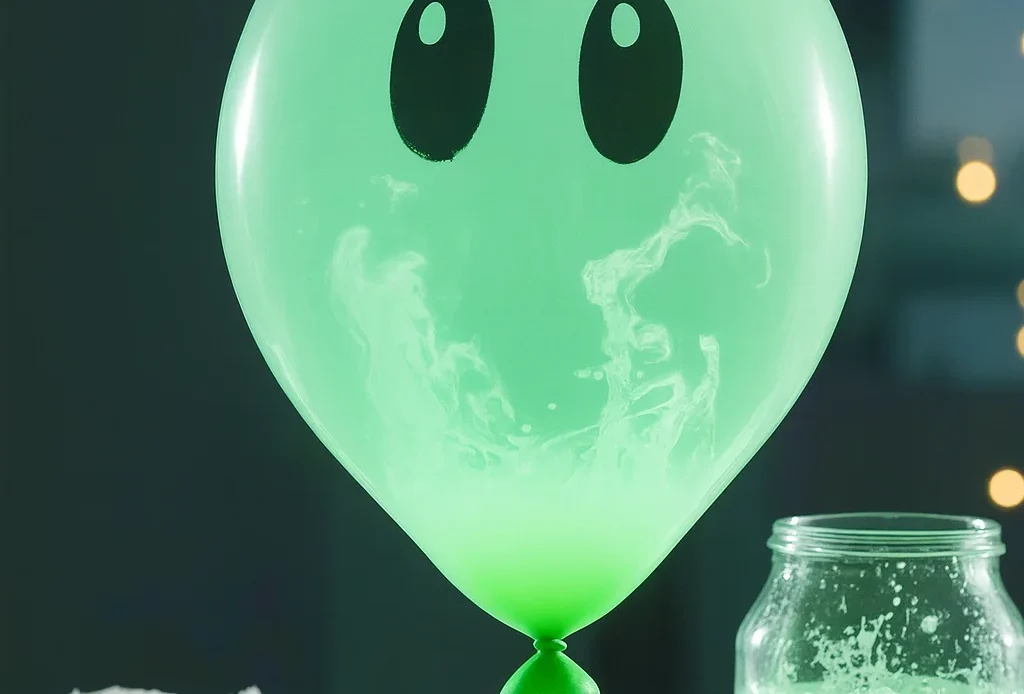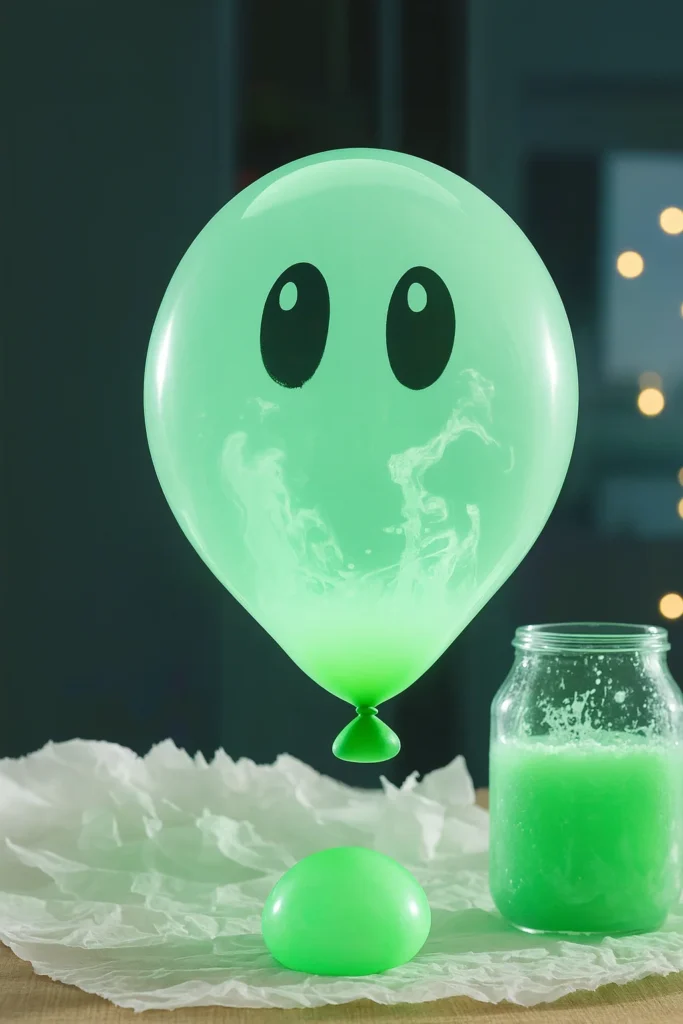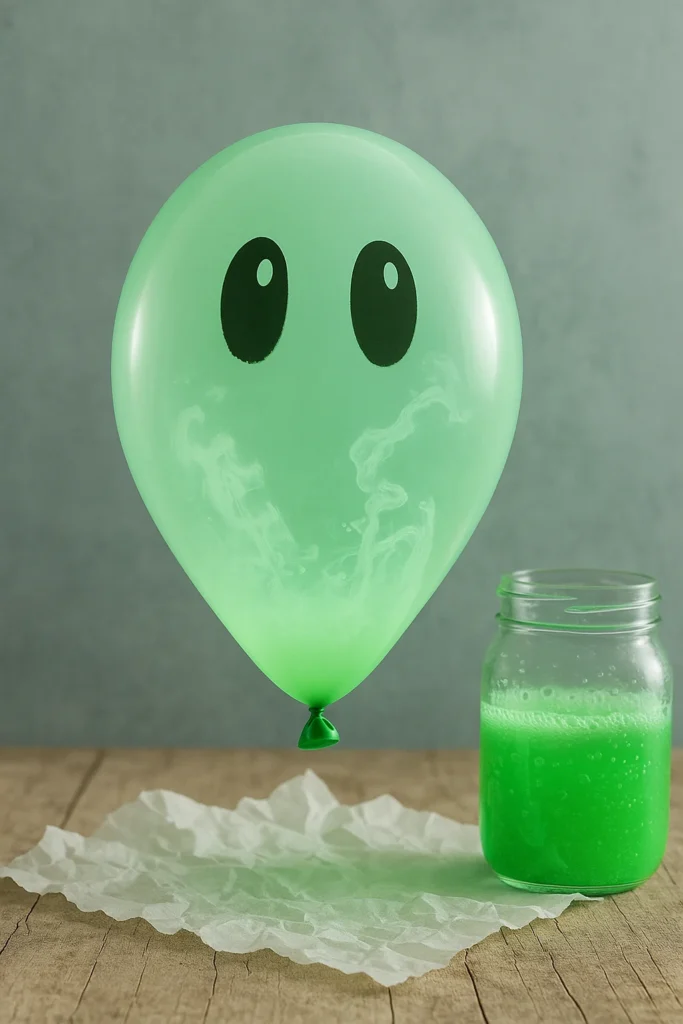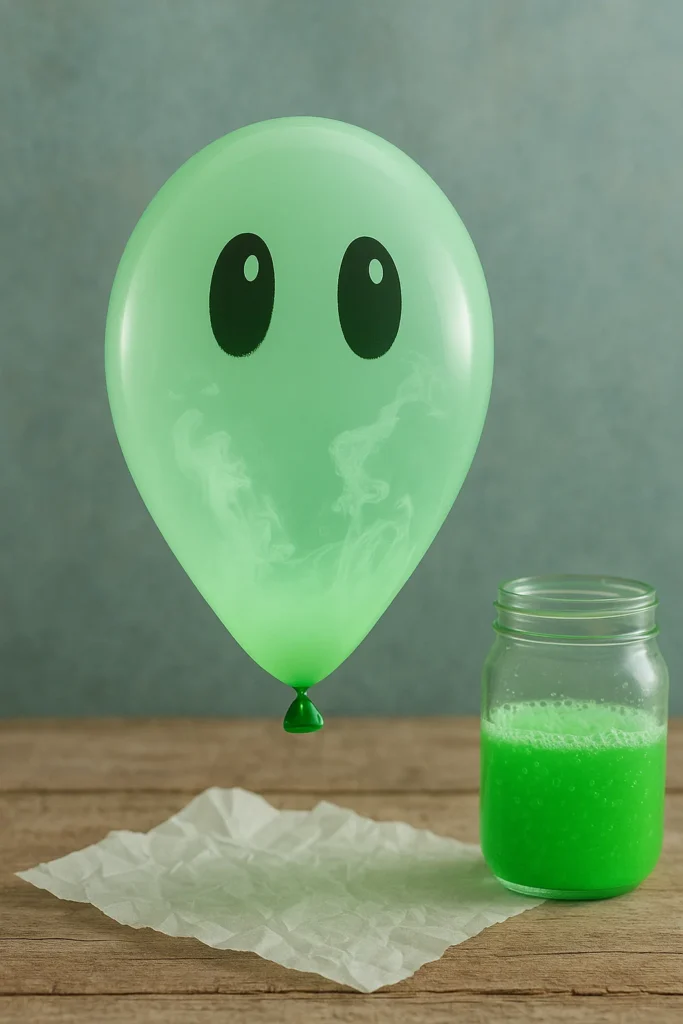
Ever seen a ghost grow before your eyes—no strings attached? Welcome to the Baking Soda Ghost Balloon Experiment, where Halloween meets chemistry in the most fun way possible! It’s a science trick and a treat.
In this super simple experiment, a balloon magically inflates using the fizzy reaction between baking soda and vinegar—classic science with a spooky twist. It’s the perfect hands-on activity for curious little scientists and busy parents alike. All you need are a few basic supplies, a little Halloween spirit, and maybe a ghostly giggle or two.
Let’s dive in and bring some spooky science to life!

What You’ll Need for the Ghost Balloon Experiment
Alright, let me be real with you—I’ve tried so many DIY science kits, and while some are cool, most either cost a fortune or end up collecting dust after one use. That’s why this Halloween science experiment is gold. It’s budget-friendly, takes 5 minutes to set up, and the giggles? Totally worth it.
🎈 My First Time… and What I Forgot
So, picture this: it’s October 29th, 7:30 p.m., my kid says, “Can we do a spooky science project?” Cue me digging through kitchen cabinets in panic mode. I had baking soda (thank goodness), but no funnel. Pro tip: don’t use a paper straw as a funnel unless you want baking soda EVERYWHERE. I learned that the hard way.
🧂 Ingredients Checklist (Seriously, Don’t Skip These)
Here’s what you actually need to pull this off like a pro:
- 1 white balloon – White gives the “ghost” vibe, but honestly, any color works.
- 2 tablespoons baking soda – The fizzy fuel.
- ¼ cup vinegar – The bubbly base.
- Small plastic bottle or container – I used an empty mini water bottle.
- Funnel – Or roll up a sheet of paper. Just not a straw.
- Optional: food coloring (makes it even more magical), essential oils (like peppermint = spooky fresh!), and glow-in-the-dark paint if you’re going full haunted lab.
🧪 Why These Supplies Matter
This isn’t just a craft—it’s a STEM activity for kids that teaches basic chemistry. When the acetic acid in vinegar reacts with the sodium bicarbonate in baking soda, it produces carbon dioxide gas. The gas fills the balloon and… poof—you’ve got a ghost!
You don’t need a fancy lab or overpriced DIY science kits to make this memorable. Just a few everyday items, a splash of curiosity, and boom—hands-on learning for children that doesn’t feel like homework.
⚠️ Quick Safety Tip
The reaction is safe, but it can overflow if you add too much baking soda. Trust me—no one wants vinegar fizz on the couch. Keep a towel nearby and always supervise younger kids.
Step-by-Step Guide to the Baking Soda Ghost Balloon Experiment
Okay, so you’ve got your ingredients. Now what? Time to bring this balloon science experiment to life—and honestly, it’s the easiest 10 minutes of educational fun you’ll ever pull off. I’ve done this with kids from ages 4 to 10, and each time, their little jaws drop when the balloon starts growing like a spooky ghost.
🧪 Step 1: Load the Balloon with Baking Soda
This part feels like loading up a tiny science cannon. I use a funnel (because I finally bought one after the straw fiasco), but if you’re short on supplies, just roll a piece of paper into a cone. Carefully spoon about 2 tablespoons of baking soda into the balloon.
💡 Pro tip: Hold the balloon neck tight so the powder doesn’t poof back out. I’ve accidentally powdered my cat once. Don’t ask.
🧪 Step 2: Fill the Bottle with Vinegar
Grab a clean plastic bottle (a water or soda bottle works great) and pour in ¼ cup of vinegar. This is where you can jazz it up—add a few drops of food coloring if you want colored ghosts. We went with green last Halloween. Looked like a radioactive goblin. 👻
Optional but fun: add a drop of peppermint essential oil. The ghost smells fresh as heck and my kids love it.
🧪 Step 3: Attach the Balloon (But Don’t Tip It Yet!)
Stretch the balloon’s opening over the bottle’s mouth without letting any baking soda fall in yet. This part is kinda tricky—if the balloon slips, you’ll get vinegar splash. I usually hold the bottle steady and gently roll the balloon neck down over it.
🧪 Step 4: Lift and Watch the Magic Happen
Here’s where it gets wild. Slowly lift the balloon so the baking soda drops into the vinegar. Within seconds—POOF!—the balloon starts inflating on its own. That fizzing noise? Music to every kid’s ears.
My daughter screamed, “It’s ALIVE!” like a tiny mad scientist. Made my whole week.
🧪 Step 5: Tie It Off and Decorate
Once it’s puffed up (it’ll stop inflating on its own), carefully remove the balloon and tie it. Now grab a marker and draw spooky ghost faces! Googly eyes, vampire teeth, whatever their creepy little hearts desire.
We even stuck glow-in-the-dark stickers on one. Looked like Casper’s cousin after a rave.
This DIY chemistry project for kids is more than just fun—it’s a hands-on way to teach reactions, gas formation, and even patience (kids will want to pop the balloon immediately… resist!).

How the Science Works – Fun Chemistry for Kids
I’ll be honest—when I first tried this ghost balloon thing, I didn’t totally get the science. It just looked cool. But once my kid hit me with a “Why does it do that?”… I panicked. Thank goodness for Google and flashbacks to 8th grade chem class.
🎓 A Little Chemistry 101
Here’s what’s actually going on: when you mix baking soda (a base) with vinegar (an acid), they start a chemical reaction that creates carbon dioxide gas. And that gas? It needs somewhere to go. Since it can’t escape through the bottle, it fills the balloon instead. Boom—inflating ghost balloon.
This is the same type of carbon dioxide reaction that makes volcano projects explode or helps cakes rise in the oven. Only this time, it’s turning a limp balloon into a spooky science float.
🧪 Why Kids LOVE It (And Why Teachers Do, Too)
The best part is that this educational science experiment is visual, loud, and a little messy—aka, perfect for kids. They don’t even realize they’re learning. Teachers love it because it’s quick, safe, and hits all the checkboxes: observation, prediction, reaction, and results.
I used it as a last-minute chemistry for kids demo during a homeschool co-op. Every single kid went home talking about “ghosts that farted gas into balloons.” Hey, science sticks when it’s funny.
✍️ Real Talk: This Is Hands-On Science Learning That Works
There’s something magical about showing kids how chemical reactions work in real time. It’s not reading from a textbook or watching a YouTube video—it’s doing it themselves. They see, hear, feel, and smell the change happening.
If your child’s curious or even remotely into science-y stuff, this experiment lights that spark.
And let’s be honest… watching a balloon puff up like a ghost and dance around is way more fun than worksheets.
Creative Variations to Try
Okay, so you’ve done the standard ghost balloon experiment—but don’t stop there! This is where the fun really begins. The best part about this being a DIY educational activity is that you can remix it a hundred different ways. I’ve tested a bunch with my own kids and a few neighbor kids (who now think I’m a mad scientist), and I’ve got some crowd favorites.
👻 Glow-in-the-Dark Ghosts
First time I added glow-in-the-dark paint, my son lost his mind. We turned off the lights and watched this floating ghost balloon pulse like a neon ghoul. Just smear a thin layer of non-toxic glow paint on the balloon before inflating. Charge it up under a lamp, then release the spooky.
Trust me—this one turns your kitchen into a haunted lab.
🎨 Add Personality with Spooky Faces
This one’s easy but never gets old. Once the balloon’s inflated, we go nuts with Sharpies. Vampire fangs, googly eyes, even one with a mustache (because why not?). My daughter named hers “Gerald the Ghost” and made him a paper cape. It’s like Halloween crafts for kids + science = perfection.
🌿 Scented Ghost Balloons
This sounds weird but… add a drop of essential oil (like lavender or peppermint) to the vinegar. When the balloon inflates, the smell hits you right in the face. It’s science and aromatherapy. Great for sensory science play, especially for younger kids.
🍏 Try Apple Cider Vinegar
Switching up the type of vinegar actually changes the fizz a bit! Apple cider vinegar smells better (IMO) and makes the fizz foamier. The first time we tried it, the balloon filled faster and made a cool bubbling sound that totally freaked out our cat.
💡 Bonus Tip: Add Glitter (Maybe…)
So here’s the thing: glitter looks magical, but it will get everywhere. We mixed a little in the baking soda once—looked like a fairy ghost explosion. Would I do it again? Eh, maybe outdoors. 😂
These creative STEM activities turn one simple experiment into a full afternoon of spooky, fizzy, artsy fun. And the best part? The kids think they’re just playing, but you know they’re soaking up hands-on learning with every bubble.

Educational Benefits for Kids
I’ve gotta say—this ghost balloon experiment may seem like a fun little Halloween craft, but it’s loaded with learning. The first time we did it, my youngest was just thrilled to see the balloon puff up. But the second time? He started asking why it happened. That’s when I realized—this isn’t just fun. It’s real STEM learning at home.
🧠 Teaches Real Science Concepts
With just two pantry staples, kids are introduced to some of the core ideas in chemistry. Acid-base reactions, gas formation, and cause and effect all show up in this simple fizzy show. My son now thinks carbon dioxide is “ghost air.” Accurate? Close enough.
Plus, it builds a basic understanding of how invisible gases can create physical change. It’s science they can see, feel, and even hear. That fizz? That’s the sound of curiosity sparking.
📚 Supports Homeschool and Classroom Lessons
I’ve used this as part of our homeschool science curriculum and even pitched it to a teacher friend who brought it into her classroom. It fits great into lessons about states of matter, physical changes, and even Halloween-themed STEM week.
It’s also adaptable for different age levels—little ones love the spectacle, while older kids can dive into why it works. That’s rare in most science education for children.
🧩 Builds Fine Motor Skills and Focus
This surprised me, but it’s true—getting that baking soda into the balloon takes some coordination! Younger kids practice fine motor skills without even realizing it. They also have to follow steps, observe, and focus, which is huge for early childhood development.
I’ve seen my own kids go from bouncing off the walls to laser-focused little scientists when we do this. It’s like magic. Messy, squealy, spooky magic.
❤️ Encourages Curiosity and Confidence
There’s something amazing about watching a child do something that feels like “real science.” They go from hesitant to confident in minutes. After this, my daughter wanted to invent her own experiment. That’s the goal, right?
When you mix fun with science exploration, kids feel empowered. They’re not just watching—they’re creating, asking questions, and getting their hands dirty.
This isn’t just a craft or a way to kill time before trick-or-treating. It’s a chance to spark something way bigger: a love of learning, curiosity, and confidence in their ability to figure things out. And that? That’s priceless.
There you have it—a fizzing, bubbling, ghostly balloon that doubles as both a fun science activity for kids and a Halloween showstopper! Whether you’re diving into STEM at home, filling out a homeschool science plan, or just want to do something different this October, the Baking Soda Ghost Balloon Experiment delivers.
It’s simple, safe, and sparks big curiosity from little learners. Add your own spooky twist—glow paint, scents, goofy faces—and you’ve got yourself a full-on DIY Halloween project that educates and entertains.
So if you loved this idea (and you’re already imagining a balloon army of haunted science ghosts), do me a favor: pin this post to your Halloween board. Help other parents and teachers discover a fun way to bring science to life—and maybe even make a few ghosty memories along the way. 🎈👻


